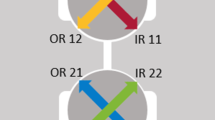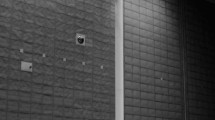Abstract
Several analytical models have been proposed to estimate the load distribution and the deformation of slewing bearing assemblies in wind turbine generators (WTGs). Even though they are a useful tool for designers as a first approach, most of them assume rigid rings and rigid supporting structures, leading to inaccurate results; even if compliance is considered in some models, only certain boundary conditions can be taken into account, and their complex and diverse nature make often these models inaccurate. For this reason, WTG manufacturers need costly FE analyses to obtain results adapted to the particular geometries and operational conditions of their yaw and pitch bearings assemblies. In this sense, this work presents a superelement-based FE model that significantly reduces the computational cost with a negligible accuracy loss.
















Similar content being viewed by others
References
Hau E (2006) Wind turbines: fundamentals, technologies, application, economics, 2nd edn. Springer, Berlin. ISBN 3540570640
Aguirrebeitia J, Avilés R, Fernandez de Bustos I, Abasolo M (2010) Calculation of the general static load-carrying capacity for the design of four contact point slewing bearings. ASME J Mech Des 132:064501
Aguirrebeitia J, Avilés R, Fernández de Bustos I, Abasolo M (2012) Calculation of general static load-carrying capacity for the design and selection of three-row roller slewing bearings. Mech Mach Theory 48:52–61
Aguirrebeitia J, Plaza J, Abasolo M, Vallejo J (2012) General static load-carrying capacity of four-contact-point slewing bearings for wind turbine generator actuation systems. Wind Energy. doi:10.1002/we.1530
Aguirrebeitia J, Abasolo M, Avilés R, Fernández de Bustos I (2012) General static load-carrying capacity for the design and selection of four contact point slewing bearings: finite element calculations and theoretical model validation. Finite Elem Anal Des 55:23–30
Aguirrebeitia J, Plaza J, Abasolo M, Vallejo J (2013) Effect of the preload in the general static load-carrying capacity of four-contact-point slewing bearings for wind turbine generators: theoretical model and finite element calculations. Wind Energy. doi:10.1002/we.1656
International Organization for Standardization, Rolling Bearings—Static Load Ratings, ISO 76:2006, 3rd edn
Zupan S, Prebil I (2001) Carrying angle and carrying capacity of a large single row ball bearing as a function of geometry parameters of the rolling contact and the supporting structure stiffness. Mech Mach Theory 36:1087–1103
Smolnicki T, Rusinski E (2007) Superelement-based modeling of load distribution in large-size slewing bearings. ASME J Mech Des 129:082601
Smolnicki T, Derlukiewicz D, Stańco M (2008) Evaluation of load distribution in the superstructure rotation joint of single-bucket caterpillar excavators. Autom Constr 17:218–223
Ludwik K, Krynke M, Mazanek E (2012) A catalogue capacity of slewing bearings. Mech Mach Theory 58:29–45
Krynke M, Selejdak J, Borkowski S (2013) Determination of static limiting load curves for slewing bearing with application of the finite element methods. Mater Eng 20:64–70
Daidié A, Chaib Z, Ghosn A (2008) 3D simplified finite elements analysis of load and contact angle in a slewing ball bearing. J Mech Des 130:082601-1
Chen G, Wen J (2012) Load performance of large-scale rolling bearings with supporting structure in wind turbines. J Tribol 134(4):041105. doi:10.1115/1.4007349
Olave M, Damian J, Serna A, Sagartzazu X (2010) Design of four contact-point slewing bearing with a new load distribution procedure to account for structural stiffness. ASME J Mech Des 132(2):021006. doi:10.1115/1.4000834
Lacroix S, Nélias D, Leblanc A (2013) Four-point contact ball bearing model with deformable rings. J Tribol 135:031402-1
Leblanc A, Nelias D (2007) Ball motion and sliding friction in a four-contact-point ball bearing. J Tribol 129(4):801–808
Leblanc A, Nelias D (2008) Analysis of ball bearings with 2, 3 or 4 contact points. Tribol Trans 51(3):372–380
Kania L, Krynke M (2013) Computation of the general carrying capacity of slewing bearings. Eng Comput 30(7):1011–1028
Potočnik R, Göncz P, Glodež S (2013) Static capacity of a large double row slewing ball bearing with predefined irregular geometry. Mech Mach Theory 64:67–79
Komzsik L (2009) What every engineer should know about computational techniques of finite element analysis, 2nd edn. CRC Press (Taylor & Francis Group). ISBN-10: 1439802947, ISBN-13: 978-1439802946
Acknowledgments
The authors wish to acknowledge the financial support of the Spanish Ministry of Economy and Competitiveness (MINECO) through Grant Number DPI2013-41091-R and the University of the Basque Country (UPV/EHU), Grant Numbers UFI11/29 and US14/09.
Author information
Authors and Affiliations
Corresponding author
Rights and permissions
About this article
Cite this article
Plaza, J., Abasolo, M., Coria, I. et al. A new finite element approach for the analysis of slewing bearings in wind turbine generators using superelement techniques. Meccanica 50, 1623–1633 (2015). https://doi.org/10.1007/s11012-015-0110-7
Received:
Accepted:
Published:
Issue Date:
DOI: https://doi.org/10.1007/s11012-015-0110-7




